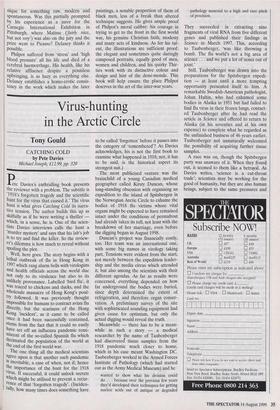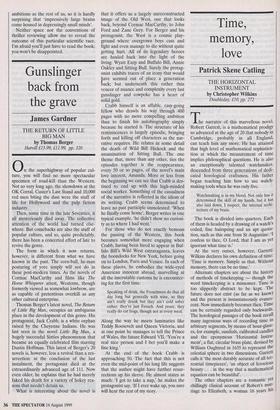Virus-hunting in the Arctic Circle
Tony Gould
CATCHING COLD by Pete Davies Michael Joseph, £12.99, pp. 320 Pte Davies's enthralling book presents the reviewer with a problem. The subtitle is `1918's forgotten tragedy and the scientific hunt for the virus that caused it.' The virus hunt is what gives Catching Cold its narra- tive tension. The author builds this up as skilfully as if he were writing a thriller which, in a sense, he is. One of the scien- tists Davies interviews calls the hunt a `murder mystery' and says that his lab's job is to try and find the killer. So the review- er's dilemma is how much to reveal without spoiling the plot. Well, here goes. The story begins with a lethal outbreak of flu in Hong Kong in 1997 which rang alarm bells with virologists and health officials across the world due not only to its virulence but also to its unlikely provenance. Labelled 'bird flu', it was traced to chickens and ducks, and the wholesale massacre of Hong Kong's poul- try followed. It was previously thought Impossible for humans to contract avian flu directly, but the scariness of the Hong Kong 'incident', as it came to be called once it had been successfully contained, stems from the fact that it could so easily have set off an influenza pandemic remi- niscent of the so-called Spanish flu which decimated the population of the world at the end of the first world war.
The one thing all the medical scientists agree upon is that another such pandemic Is inevitable, a case of when, not if; hence the importance of the hunt for the 1918 virus. If successful, it could unlock secrets which might be utilised to prevent a recur- rence of that 'forgotten tragedy'. (Inciden- tally, how many times does something have to be called 'forgotten' before it passes into the category of 'remembered'? As Davies acknowledges, his is not the first book to examine what happened in 1918; nor, it has to be said, is the historical aspect its strongest suit.) The most publicised venture was the brainchild of a young Canadian medical geographer called Kirsty Duncan, whose long-standing obsession with organising an expedition to the island of Spitsbergen in the Norwegian Arctic Circle to exhume the bodies of 1918 flu victims whose vital organs might be expected to have remained intact under the conditions of permafrost had already taken its toll, not least with the breakdown of her marriage, even before the digging began in August 1998.
Duncan's project was financially costly, too. Her team was an international one, with some big names in virology taking part. Tensions were evident from the start, not merely between the expedition leader- ship and the media circus which attended it, but also among the scientists with their different agendas. As far as results were concerned, everything depended on how far underground the bodies were buried, since depth determined the extent of refrigeration, and therefore organ conser- vation. A preliminary survey of the site with sophisticated sounding equipment had given cause for optimism, but only the actual digging would reveal the truth.
Meanwhile — there has to be a mean- while in such a story — a medical researcher by the name of Taubenberger had discovered tissue samples from the 1918 pandemic much closer to home, which in his case meant Washington DC. Taubenberger worked in the Armed Forces Institute of Pathology (which had started out as the Army Medical Museum) and he
wanted to show what his division could do . . . because over the previous few years they'd developed their techniques for getting nucleic acids out of antique or degraded pathology material to a high and rare pitch of precision.
They succeeded in extracting nine fragments of viral RNA from five different genes and published their findings in Science in March 1997. This, according to Taubenberger, 'was like throwing a bomb. The flu world's not a big area of science . . . and we put a lot of noses out of joint.'
Still, Taubenberger was drawn into the preparations for the Spitsbergen expedi- tion — at least until a more tempting opportunity presented itself to him. A remarkable Swedish-American pathologist, Johan Hultin, who had exhumed some bodies in Alaska in 1951 but had failed to find flu virus in their frozen lungs, contact- ed Taubenberger after he had read the article in Science and offered to return to Alaska (in his seventies and at his own expense) to complete what he regarded as the unfinished business of 46 years earlier. Taubenberger not unnaturally welcomed the possibility of acquiring further tissue samples.
A race was on, though the Spitsbergen party was unaware of it. When they found out, it seemed to them like a betrayal. As Davies writes, 'science is a cut-throat trade'; scientists may be working for the good of humanity, but they are also human beings, subject to the same pressures and ambitions as the rest of us, so it is hardly surprising that 'impressively large brains come housed in depressingly small minds'.
Neither space nor the conventions of thriller reviewing allow me to reveal the outcome of this particular scientific race. I'm afraid you'll just have to read the book; you won't be disappointed,



























































 Previous page
Previous page